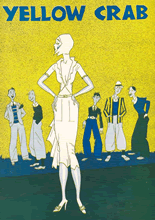
|
In
December 1914 there appeared on the DePauw campus the first issue
of the Yellow Crab, a humor magazine sponsored by the journalism
fraternity, Sigma Delta Chi. Its editors announced that the journal
would accept no advertising and contain "nothing literary,
nothing serious, nothing sensible." Subsequent issues, published
irregularly over the next several years, became increasingly brash
and risqué, often provoking the sarne kind of official displeasure
as the boguses of an earlier era. In 1919 the faculty decreed that
no further numbers could be issued without approval by university
authorities. Despite this form of censorship the Yellow Crab continued
to be a lively student publication, excerpts from it appearing occasionally
in the national journal College Humor in the 1920s.
____________________________________________
Less controversial was the DePauw Magazine, founded in the fall
of 1919 by Professor Raymond W. Pence as a means of encouraging
student literary expression. This quarterly journal contained a
variety of articles, short stories, poetry, and book reviews as
well as a few local advertisements to help pay printing costs. In
the early 1920s Doubleday, Page, & Company collaborated with
the editorial staff in the award of an annual O. Henry prize to
the student submitting the best short story. The prize consisted
of a complete leather-bound set of the collected works of William
Sydney Porter, who wrote under the pen name O. Henry. From 1935
to 1937 the DePauw Magazine was issued in a larger and more attractive
format, with a colorful cover and black and white illustrations.
Financial constraints, however, brought about its demise in the
latter year. It was not to be revived for nearly two decades. |
Depauw University e-history | E-mail comments to: archives@depauw.edu


